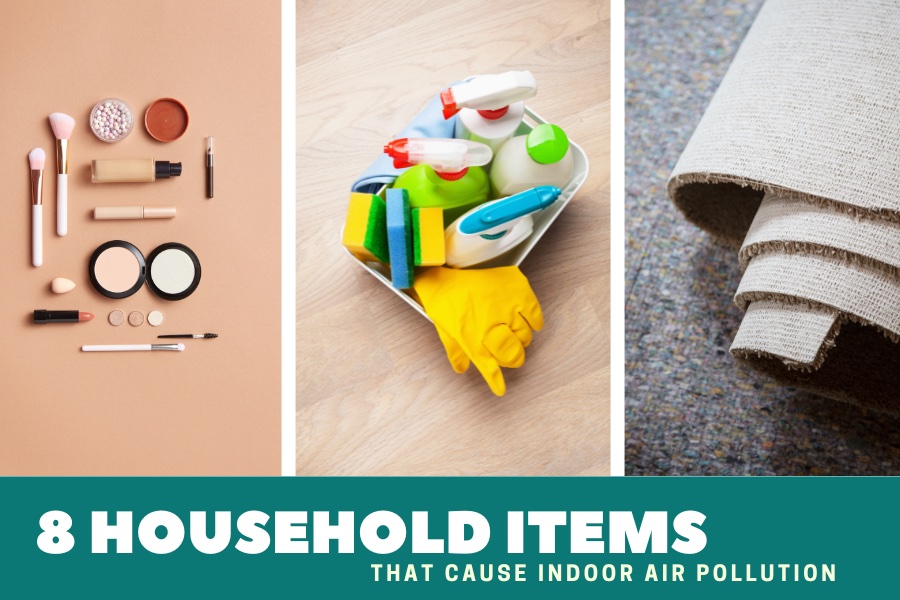
Approximately 90% of our breaths are taken indoors, and a significant portion of these occur within our own homes. This makes managing indoor air quality crucial for maintaining good health. However, our homes often harbor a variety of contaminants, emanating from everyday household items that cause pollution. These pollutants can lead to issues such as poor sleep, headaches, aggravated allergies, and even more serious health problems.
Here are the 8 household items most likely to cause air pollution:
1. Cleaning Products and Disinfectants
Cleaning products, air fresheners, and disinfectant sprays create indoor air pollution by releasing volatile organic compounds (VOCs) into your indoor air. VOCs can contribute to respiratory irritation and allergies, especially for vulnerable individuals with existing conditions such as asthma.
Solution: This is a tricky one because a dirty house is also highly likely to create air quality issues. Not cleaning is not an option. Instead, use safe alternatives to chemical cleaners such as baking soda, vinegar, and lemon juice.
2. Carpets and Flooring
New carpets often contain synthetic fibers like nylon and polyester, which are treated with harsher stuff to resist stains, repel insects, and last longer. Over time, these chemicals break off into the air and are easily inhaled. Floors, meanwhile, often use vinyl and laminate, which cause VOCs to circulate in the air.
Solution: Choose carpets and flooring made from natural materials or that have been certified by green-friendly organizations. Vacuum carpets, sweep floors, and dust and mop regularly to help reduce the presence of dust, pollen, and other pollutants.
3. Furnishings and Building Materials
Furniture and home furnishings that you bring into your house frequently contain formaldehyde, which is one of the EPA’s 13 most common indoor air pollutants. These items may use particleboard, MDF, or pressed wood, and also contain antimicrobial treatments, flame retardants,and adhesives, all known to create pollutants. Additionally, plywood, insulation, and construction materials can release VOCs.
Solution: Shop for natural products, invest in non-toxic insulation, and avoid anything with formaldehyde. Consider having an inspector test for asbestos. Hire or consult a certified green contractor for new construction projects.
4. Paint
Oil-based paints contain VOCs that can enter the air during and after painting. Many older homes have lead-based paints. Lead is a highly toxic air pollutant linked to poisoning, neurological disorders, and other illnesses. Paint thinners, varnish, and paint solvents can contain other harmful chemicals, such as VOCs, formaldehyde, and acetaldehyde.
Solution: Paint with non-VOC paints, opting for water-based paints instead. Have a professional inspect your home if you’re concerned about lead-based paints, which can create harmful pollution even when painted over.
5. Pet Waste
Pets shed dander, which is microscopic flecks of skin that can be inhaled and irritate airways or cause allergies. Pets also leave saliva, urine, fur, and dirt throughout indoor spaces. These may contain bacteria, dust, mold, pollen and other small particles that circulate in the air.
Solution: Groom pets to reduce shedding of hair and dander. Regularly clean and vacuum all spaces where pets spend time.
6. Personal Care Products
The following products can produce a high volume of VOCs, especially when more than one is used: hairspray, deodorant, air fresheners, perfumes, colognes, scented soap, scented lotion, nail polish, nail polish remover, hair gel, mousse, and many kinds of makeup.
Solution: Shop for natural products and products with non-VOC labels, avoid scented care products, use aerosols sparingly, always make sure you have good ventilation.
7. Moisture and Mold
One of the most dangerous and common indoor air pollutants is mold, due to the health risks of mycotoxins which are released into the air by mold spores. Mold grows in damp and warm places, which include bathrooms, kitchens, and nooks and crannies of your home with limited ventilation.
Solution: Identify areas with water damage or potential water entry and stop any leaks. Inspect your house for mold using our handy guide to mold detection. If you aren’t sure, call a professional.
8. Pests and Pesticides
For the last item on our list, both the problem and the solution pose an air quality threat. Bugs, vermin, and other unwanted home invaders leave feces, saliva, body parts, eggs, dirt, and bacteria that enter the air and agitate allergies and asthma. Indoor use of pesticides and insecticides to control this problem often introduces harmful chemicals.
Solution: Exterminate pests with natural repellents, traps, and exclusions, instead of using chemicals. Keep your home clean and remove food sources that attract pests.
Avoiding Household Items That Cause Pollution
One way to protect yourself and your family household air pollution is by knowing exactly what is in your air at any given moment. With IAQ you can access real-time readings on your indoor air or get alerted when air quality drops. Support IAQ on Indiegogo today.







